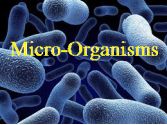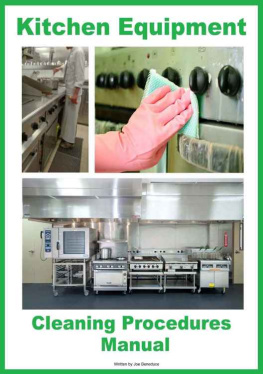 KITCHEN EQUIPMENT CLEANING PROCEDURES MANUAL Disclaimer This book is designed to provide information on kitchen equipment cleaning only. This information is provided and sold with the knowledge that the publisher and author do not offer any legal or other professional advice. In the case of a need for any such expertise consult with the appropriate professional. This book does not contain all information available on the subject. This book has not been created to be specific to any individuals or organizations situation or needs. Every effort has been made to make this book as accurate as possible.
KITCHEN EQUIPMENT CLEANING PROCEDURES MANUAL Disclaimer This book is designed to provide information on kitchen equipment cleaning only. This information is provided and sold with the knowledge that the publisher and author do not offer any legal or other professional advice. In the case of a need for any such expertise consult with the appropriate professional. This book does not contain all information available on the subject. This book has not been created to be specific to any individuals or organizations situation or needs. Every effort has been made to make this book as accurate as possible.
However, there may be typographical and or content errors. Therefore, this book should serve only as a general guide and not as the ultimate source of subject information. This book contains information that might be dated and is intended only to educate and entertain. The author and publisher shall have no liability or responsibility to any person or entity regarding any loss or damage incurred, or alleged to have incurred, directly or indirectly, by the information contained in this book. You hereby agree to be bound by this disclaimer. 2014 FOREWORD The recommendations in this Manual are intended as a guide only to catering managers and workplace supervisors from the cleaning industry, to enable them to achieve and maintain adequate standards of hygiene in respect of cleaning practices in all areas of the commercial kitchen. 2014 FOREWORD The recommendations in this Manual are intended as a guide only to catering managers and workplace supervisors from the cleaning industry, to enable them to achieve and maintain adequate standards of hygiene in respect of cleaning practices in all areas of the commercial kitchen.
This manual is written by Joe Beneduce Facilities & Health Support Senior Instructor for the cleaning Industry Other publications in the series include: Hospital Cleaning Procedures Manual Hospital Cleaning Operators Manual Cleaning of Infectious Areas Operating Suite Cleaning Manual TABLE OF CONTENTS Page No. SECTION 1 INTRODUCTION SECTION 2 THE NEED FOR KITCHEN CLEANING 2.1 Food Poisoning 11 2.2 Food Contamination 12 2.3 Means of Contamination 13 2.4 Prevention of Contamination 14 2.5 Cleaning Requirements 14 2.6 Warnings 15 SECTION 3 PRODUCTION EQUIPMENT 3.1 Bratt /Frypan - Tilting 17 3.2 Cooking Top - Electric 17 3.3 Cooking Top - Gas 18 3.4 Fryer 19 3.5 Oil Filter 21 3.6 Griller/Griller Top 22 3.7 Oven - Baking/Roasting 24 3.8 Oven - Convection 25 3.9 Oven - Microwave 26 3.10 Salamander 27 3.11 Steamer - Pressure and Atmospheric 28 3.11.1 Well - Type Steamer 29 3.12 Stockpot/Boiling Pots 30 Page No SECTION 4 PREPARATION EQUIPMENT 4.1 Butcher's Block 32 4.2 Bowl Cutter/Food Chopper 32 4.3 Scales - Counter 33 4.4 Scales - Platform 34 4.5 Food Mixer 29 4.6 Mincing Machine/Attachments 35 4.7 Potato Peeler 35 4.8 Slicing Machine - Automatic 36 4.9 Toaster - Conveyor Type 37 SECTION 5 FOOD SERVICE EQUIPMENT 5.1 Bain-Marie 39 5.2 Drink/Juice Dispenser 40 5.3 Multiport/Urn - Electric (Hot water/Coffee} 40 5.4 Tray Service Slide 40 5.5 Tray Service Belt 42 5.6 Trolleys - General Purpose, Tray and Mobile Rack 42 Page No. SECTION 6 UTENSIL DISHWASHING EQUIPMENT 6.1 Flite Conveyor/Rack Conveyor Dishwasher 44 6.2 Pot/Utensil Washer - Single Rack or Basket Dishwasher 44 6.3 Waste Disposal Unit 45 SECTION 7 CARE AND HANDLING OF UTENSILS 7.1 Aluminium 47 7.2 Stainless Steel 47 7.3 Chromium 48 7.4 Nickel 48 7.5 Silver 48 7.6 Tin 48 7.7 Glaze 48 7.8 Plastic 48 7.9 Rubber 49 7.10 Wood 49 7.11 Iron 49 7.12 Brass 49 7.13 Copper 50 Page No. SECTION 8 STORAGE FACILITIES 8.1 Cool Room/Freezer - Walk-In 53 8.2 Refrigerator 54 8 .3 Storage Bin - Dry Food 55 8.4 Store - Dry Food 56 SECTION 9 MISCELLANEOUS 9.1 Hood ventilator 59 9.2 Hood Filter 59 GLOSSARY SECTION 1  INTRODUCTION
INTRODUCTION  SECTION 1 INTRODUCTION
SECTION 1 INTRODUCTION  Food service hygiene is the responsibility of every person associated with the storage, preparation, servicing and transportation of food. However, the catering Manager has the additional responsibility for ensuring that everyone under his/her control knows the why and how of attaining maximum hygienic conditions. The aim of this Procedure Manual is to provide a guide for catering managers and workplace supervisors to enable them to achieve and maintain adequate levels of hygiene in respect of cleaning practices in all areas of the hospital kitchen.
Food service hygiene is the responsibility of every person associated with the storage, preparation, servicing and transportation of food. However, the catering Manager has the additional responsibility for ensuring that everyone under his/her control knows the why and how of attaining maximum hygienic conditions. The aim of this Procedure Manual is to provide a guide for catering managers and workplace supervisors to enable them to achieve and maintain adequate levels of hygiene in respect of cleaning practices in all areas of the hospital kitchen.
However, the instructions contained herein should not limit the Catering Manager's own discretion. Managers will ensure the provision of quality food by application of the cleaning principles and procedures established for hospital kitchens, and a properly designed cleaning programme will provide staff with a clean and hygienic environment in which to carry out their duties. It is recommended that this Equipment Cleaning Procedures Manual be used in conjunction with the Section on cleaning of kitchen areas in the Hospital Cleaning Procedures Manual. SECTION 2  THE NEED FOR KITCHEN CLEANING
THE NEED FOR KITCHEN CLEANING  SECTION 2 THE NEED FOR KITCHEN CLEANING
SECTION 2 THE NEED FOR KITCHEN CLEANING 
 2.1 FOOD POISONING Food poisoning is the overall term used to describe illnesses coursed by: a) consumption of toxic chemical agents such as lead, insecticides; b) consumption of toxic substances in natural foods such as mushrooms, seafoods; c) consumption of normally non-toxic substances in natural foods to which an individual is allergic; d) Consumption of "spoiled" food. Food spoilage refers to changes in the composition of food brought about by the action of yeasts, moulds etc.
2.1 FOOD POISONING Food poisoning is the overall term used to describe illnesses coursed by: a) consumption of toxic chemical agents such as lead, insecticides; b) consumption of toxic substances in natural foods such as mushrooms, seafoods; c) consumption of normally non-toxic substances in natural foods to which an individual is allergic; d) Consumption of "spoiled" food. Food spoilage refers to changes in the composition of food brought about by the action of yeasts, moulds etc.  SECTION 2 THE NEED FOR KITCHEN CLEANING
SECTION 2 THE NEED FOR KITCHEN CLEANING 
 2.2 FOOD CONTAMINATION 2.2.1 Bacteria Bacteria are microscopic organisms that may cause disease.
2.2 FOOD CONTAMINATION 2.2.1 Bacteria Bacteria are microscopic organisms that may cause disease.  SECTION 2 THE NEED FOR KITCHEN CLEANING
SECTION 2 THE NEED FOR KITCHEN CLEANING 
 2.2 FOOD CONTAMINATION 2.2.1 Bacteria Bacteria are microscopic organisms that may cause disease.
2.2 FOOD CONTAMINATION 2.2.1 Bacteria Bacteria are microscopic organisms that may cause disease.
Next page










 KITCHEN EQUIPMENT CLEANING PROCEDURES MANUAL Disclaimer This book is designed to provide information on kitchen equipment cleaning only. This information is provided and sold with the knowledge that the publisher and author do not offer any legal or other professional advice. In the case of a need for any such expertise consult with the appropriate professional. This book does not contain all information available on the subject. This book has not been created to be specific to any individuals or organizations situation or needs. Every effort has been made to make this book as accurate as possible.
KITCHEN EQUIPMENT CLEANING PROCEDURES MANUAL Disclaimer This book is designed to provide information on kitchen equipment cleaning only. This information is provided and sold with the knowledge that the publisher and author do not offer any legal or other professional advice. In the case of a need for any such expertise consult with the appropriate professional. This book does not contain all information available on the subject. This book has not been created to be specific to any individuals or organizations situation or needs. Every effort has been made to make this book as accurate as possible. INTRODUCTION
INTRODUCTION  SECTION 1 INTRODUCTION
SECTION 1 INTRODUCTION  Food service hygiene is the responsibility of every person associated with the storage, preparation, servicing and transportation of food. However, the catering Manager has the additional responsibility for ensuring that everyone under his/her control knows the why and how of attaining maximum hygienic conditions. The aim of this Procedure Manual is to provide a guide for catering managers and workplace supervisors to enable them to achieve and maintain adequate levels of hygiene in respect of cleaning practices in all areas of the hospital kitchen.
Food service hygiene is the responsibility of every person associated with the storage, preparation, servicing and transportation of food. However, the catering Manager has the additional responsibility for ensuring that everyone under his/her control knows the why and how of attaining maximum hygienic conditions. The aim of this Procedure Manual is to provide a guide for catering managers and workplace supervisors to enable them to achieve and maintain adequate levels of hygiene in respect of cleaning practices in all areas of the hospital kitchen. THE NEED FOR KITCHEN CLEANING
THE NEED FOR KITCHEN CLEANING  2.1 FOOD POISONING Food poisoning is the overall term used to describe illnesses coursed by: a) consumption of toxic chemical agents such as lead, insecticides; b) consumption of toxic substances in natural foods such as mushrooms, seafoods; c) consumption of normally non-toxic substances in natural foods to which an individual is allergic; d) Consumption of "spoiled" food. Food spoilage refers to changes in the composition of food brought about by the action of yeasts, moulds etc.
2.1 FOOD POISONING Food poisoning is the overall term used to describe illnesses coursed by: a) consumption of toxic chemical agents such as lead, insecticides; b) consumption of toxic substances in natural foods such as mushrooms, seafoods; c) consumption of normally non-toxic substances in natural foods to which an individual is allergic; d) Consumption of "spoiled" food. Food spoilage refers to changes in the composition of food brought about by the action of yeasts, moulds etc.  2.2 FOOD CONTAMINATION 2.2.1 Bacteria Bacteria are microscopic organisms that may cause disease.
2.2 FOOD CONTAMINATION 2.2.1 Bacteria Bacteria are microscopic organisms that may cause disease.